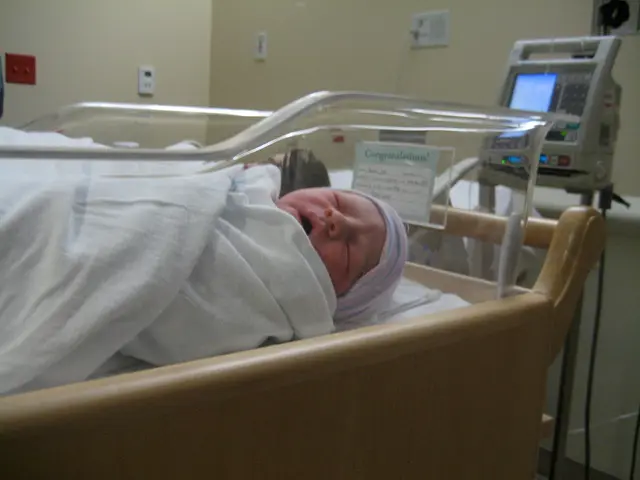Cerebellar Ataxia: Symptoms, Causes, and Available Treatments
Acute cerebellar ataxia is a common condition in children, characterised by a sudden loss of coordination and balance. The condition can be caused by several factors, including viral infections, autoimmune disorders, infections and toxins, structural abnormalities, and less commonly, autoimmune diseases, endocrine or metabolic disorders, growths in the brain, malnutrition, diabetes, stroke, or rare genetic disorders.
One of the most common causes of acute cerebellar ataxia in children is viral cerebellitis, often resulting from viral infections such as the varicella-zoster virus, which causes chickenpox. Other causes may include autoimmune disorders like multiple sclerosis or paraneoplastic syndromes, infections, toxins, structural issues like hydrocephalus or posterior fossa tumors, and less common factors mentioned earlier.
The symptoms of acute cerebellar ataxia include instability when walking, changes in coordination, unusual head and eye movements, slow or slurred speech, changes in mood, behaviour, or personality, headaches, nausea or vomiting.
Diagnosis of acute cerebellar ataxia involves ruling out other potential causes. Imaging scans, such as MRI or CT scans, blood tests, and lumbar punctures may be ordered to help diagnose the condition. A urine test can also be used to detect harmful substances ingested by the child.
Treatment for acute cerebellar ataxia depends on the underlying cause. For viral cerebellitis, supportive care is often provided, and antiviral medication may be used in some cases. Treatment for autoimmune causes may involve immunotherapy or other medications to manage symptoms and prevent further damage. Addressing the underlying infection or removing the toxin is crucial for infections and toxins, and antibiotics or antiviral medications may be necessary. For structural issues, surgery may be required to relieve pressure or repair structural abnormalities in the brain.
Rehabilitation, including physical therapy, can help improve coordination and balance, supporting recovery and management of symptoms. Long-term occupational or physical therapy may be necessary for children who do not fully recover.
Recovery from acute cerebellar ataxia usually occurs within a few weeks, but if children do not recover within a few months, other causes may need to be ruled out. In cases of acute cerebellar ataxia with an active infection, a doctor may prescribe antibiotics or antiviral drugs. Children who do not fully recover may continue to have gait or coordination problems, increasing their risk of injuries from falling.
Widespread vaccination has reduced the risk of cerebellar ataxia by preventing many diseases that can cause it. However, for hereditary forms of cerebellar ataxia, such as Friedreich's ataxia, treatment focuses on managing symptoms and preventing complications.
In conclusion, while acute cerebellar ataxia can be a concerning condition for parents, understanding its causes, symptoms, and treatment options can help provide reassurance and support effective management. If you suspect your child may have acute cerebellar ataxia, it is essential to consult a healthcare professional for a proper diagnosis and treatment plan.
Children's health is crucial, and problems like acute cerebellar ataxia should not be overlooked. This condition can be blocked due to various medical conditions, such as viral infections, autoimmune disorders, infections, and toxins, structural abnormalities, or rare genetic disorders.
Pfizer recently developed a vaccine to prevent one of the viral infections causing cerebellar ataxia, chickenpox. Science continues to advance, providing new solutions for children's health and wellness.
Sleep is vital for overall health, and disrupted sleep patterns might indicate underlying conditions, including respiratory conditions, digestive health issues, or even neurological disorders.
Workplace wellness programs focus on various aspects of health, including mental health, fitness and exercise, nutrition, skin care, eye health, and hearing. Employers are increasingly recognizing the importance of such programs to improve the overall well-being of their employees.
Cancer is a severe medical condition that requires immediate attention and therapeuties and treatments. Regular screening and early detection are essential to increase survival rates and improve quality of life.
Acute cerebellar ataxia symptoms may include changes in mood, behavior, or personality, in addition to gait instability, slurred speech, and headaches. These changes can be worrying for parents, and early recognition of these signs is vital for timely intervention.
Diabetes can also cause acute cerebellar ataxia if not managed properly. Proper nutrition and weight management are crucial in managing chronic conditions like diabetes.
Medicare provides coverage for various health-related services, including treatments for acute cerebellar atataxia, cancer, and other medical conditions. Understanding Medicare benefits is essential for elderly individuals and their families.
Autoimmune disorders, like multiple sclerosis, can cause acute cerebellar ataxia. CBD oil has shown potential in managing symptoms associated with these disorders, but further research is required to fully understand its benefits and potential risks.
Mens' health and Womens' health are equally important, with unique conditions, such as prostate cancer and breast cancer, respectively. Regular screenings and preventative care are crucial for early detection and treatment of these conditions.
Aging brings a higher risk for various health problems, including cardiovascular diseases, skin conditions, and mental health issues. Embracing a healthy lifestyle and seeking regular medical check-ups can help manage these risks.
Parenting includes providing proper care for children, including addressing their health concerns, such as acute cerebellar ataxia. It is essential to be aware of the signs and symptoms of such conditions and consult healthcare professionals for proper diagnosis and treatment.
Mental health is an essential aspect of health that often goes unaddressed. Addressing mental health concerns, such as anxiety or depression, can significantly improve overall well-being and quality of life.
Lastly, it is essential to remember that health is a continuous journey that requires attention to various aspects, including fitness, nutrition, and mental health. Early detection and timely intervention are crucial in managing various health conditions, like acute cerebellar ataxia, and maintaining overall wellness.




